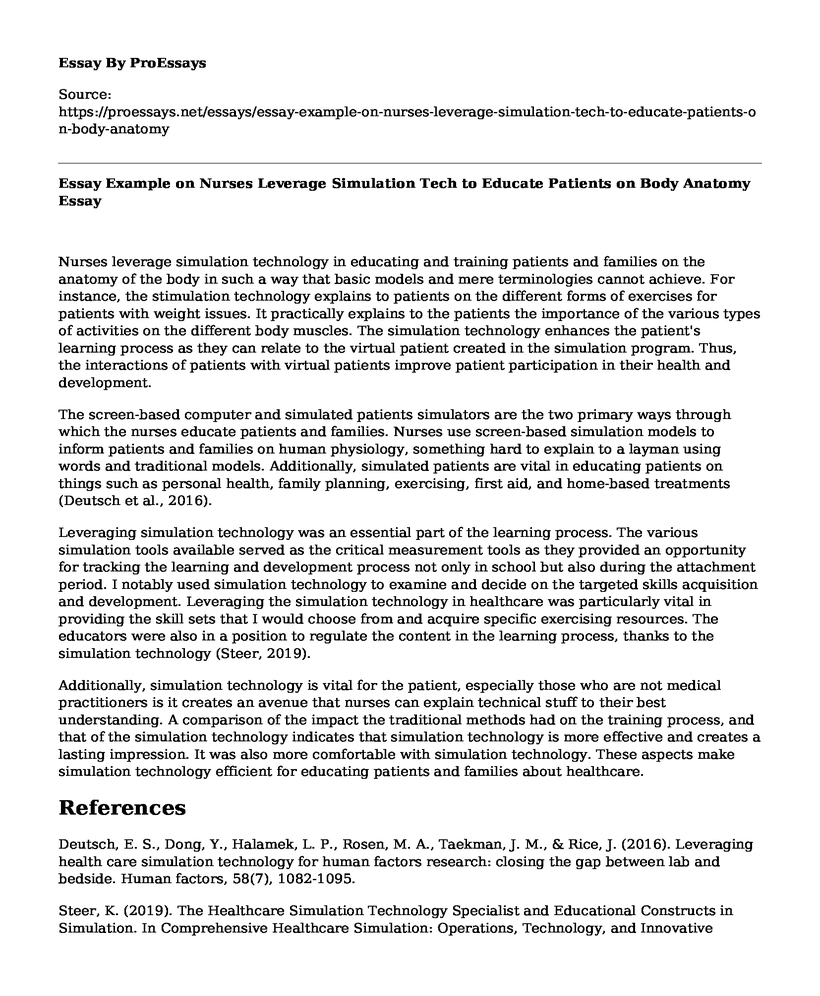Nurses leverage simulation technology in educating and training patients and families on the anatomy of the body in such a way that basic models and mere terminologies cannot achieve. For instance, the stimulation technology explains to patients on the different forms of exercises for patients with weight issues. It practically explains to the patients the importance of the various types of activities on the different body muscles. The simulation technology enhances the patient's learning process as they can relate to the virtual patient created in the simulation program. Thus, the interactions of patients with virtual patients improve patient participation in their health and development.
The screen-based computer and simulated patients simulators are the two primary ways through which the nurses educate patients and families. Nurses use screen-based simulation models to inform patients and families on human physiology, something hard to explain to a layman using words and traditional models. Additionally, simulated patients are vital in educating patients on things such as personal health, family planning, exercising, first aid, and home-based treatments (Deutsch et al., 2016).
Leveraging simulation technology was an essential part of the learning process. The various simulation tools available served as the critical measurement tools as they provided an opportunity for tracking the learning and development process not only in school but also during the attachment period. I notably used simulation technology to examine and decide on the targeted skills acquisition and development. Leveraging the simulation technology in healthcare was particularly vital in providing the skill sets that I would choose from and acquire specific exercising resources. The educators were also in a position to regulate the content in the learning process, thanks to the simulation technology (Steer, 2019).
Additionally, simulation technology is vital for the patient, especially those who are not medical practitioners is it creates an avenue that nurses can explain technical stuff to their best understanding. A comparison of the impact the traditional methods had on the training process, and that of the simulation technology indicates that simulation technology is more effective and creates a lasting impression. It was also more comfortable with simulation technology. These aspects make simulation technology efficient for educating patients and families about healthcare.
References
Deutsch, E. S., Dong, Y., Halamek, L. P., Rosen, M. A., Taekman, J. M., & Rice, J. (2016). Leveraging health care simulation technology for human factors research: closing the gap between lab and bedside. Human factors, 58(7), 1082-1095.
Steer, K. (2019). The Healthcare Simulation Technology Specialist and Educational Constructs in Simulation. In Comprehensive Healthcare Simulation: Operations, Technology, and Innovative Practice (pp. 189-204). Springer, Cham.
Cite this page
Essay Example on Nurses Leverage Simulation Tech to Educate Patients on Body Anatomy. (2023, Apr 24). Retrieved from https://proessays.net/essays/essay-example-on-nurses-leverage-simulation-tech-to-educate-patients-on-body-anatomy
If you are the original author of this essay and no longer wish to have it published on the ProEssays website, please click below to request its removal:
- Historic Epidemiological Event: Ebola Virus Disease
- Essay Example on Personal Knowledge, Skills and Abilities
- Auburn University HR Employee Handbook Information
- Research Paper on Nurses: Compassion, Depression, Patient Satisfaction & Workplace Tension/Stress
- Essay Sample on Nurse Educator: Project Aim, Goals, and Patient Safety
- Essay Example on Professional Nursing: Caring for All
- The Impact of Physical Activities on My Childhood - Essay Sample







